This article needs additional citations for verification .(November 2022) |

The Boulder Dushanbe Tea House was a gift from Mayor Maksud Ikramov of Dushanbe to the city of Boulder, Colorado. [1]
This article needs additional citations for verification .(November 2022) |

The Boulder Dushanbe Tea House was a gift from Mayor Maksud Ikramov of Dushanbe to the city of Boulder, Colorado. [1]
The Boulder Dushanbe Teahouse was created as a gift to the city of Boulder, Colorado, from its sister city Dushanbe, the capital of the Tajik Soviet Socialist Republic, then part of the Soviet Union and now Tajikistan, in 1987. Forty Tajik artisans hand-made the teahouse over a period of two years, took it apart, and then packed the pieces into about 200 crates to be shipped to Boulder. The trades used by the artisans were passed from generation to generation within families, such as the use of nature, and repetition of patterns, descendant from traditional Persian design. Also, no power tools were used in the original construction of the tea house.
Lack of funds meant that it took several years to erect the teahouse. Many dedicated individuals including former Boulder mayor Linda Jourgensen, longtime city council member Sally Martin, Boulder-Dushanbe Sister Cities members Mary Axe, Jancy Campbell, noted local architect Vern Seieroe and many others kept the project alive by continuously promoting the unique gift in the community year in and year out. [2]
Boulder-Dushanbe Sister Cities fostered the project until members helped form the Boulder-Dushanbe Teahouse Trust with other community leaders. After nearly a decade during which the teahouse remained unassembled in storage crates, many members of the community supported erecting the teahouse by donating thousands of dollars in private donations, but that was not enough. Finally, the Teahouse Trust was able to negotiate an arrangement with the City of Boulder that allowed lease revenues generated by a restaurant operator to pay for a substantial portion of the million-plus dollar funds needed to erect the structure in accordance with Boulder building codes. This arrangement was in keeping with city government sentiment that taxpayer funds should not be used for the endeavor. The teahouse was erected on city property and opened to the public in 1998. "Oral history interview with David Grimm, 2009". Boulder Library. Retrieved April 5, 2024.

It is situated along a brook that shoots off Boulder Creek in keeping with the tradition that teahouses be placed along waterways or other bodies of water. Reflecting another traditional aspect of Tajik culture, the Boulder Valley Rose Society donated and planted an elaborate rose garden on the teahouse grounds. Inside the teahouse there are uniquely designed hand-carved cedar pillars, handmade traditional Tajikistan furniture, a fountain with seven bronze statues of women based on a 12th-century poem "The Seven Beauties", original oil paintings done onsite by a Tajik artist, and traditional geometric plaster carvings. The outside decorative elements include eight ceramic tiles, which display the patterns of a "Tree of life".[ citation needed ]
The current operator is Lenny Martinelli. The building and grounds are property of the City of Boulder.

Tajikistan, officially the Republic of Tajikistan, is a landlocked country in Central Asia. Dushanbe is the capital and most populous city. Tajikistan is bordered by Afghanistan to the south, Uzbekistan to the west, Kyrgyzstan to the north, and China to the east. It is separated from Pakistan by Afghanistan's Wakhan Corridor.

The Armed Forces of the Republic of Tajikistan, also known as the Tajik National Army is the national military of the Republic of Tajikistan. It consists of Ground Forces, Mobile Forces, and the Air Force, with closely affiliated forces including the national guard, border and internal troops.

Tajiks are a Persian-speaking Iranian ethnic group native to Central Asia, living primarily in Afghanistan, Tajikistan, and Uzbekistan. Tajiks are the largest ethnicity in Tajikistan, and the second-largest in Afghanistan and Uzbekistan. They speak varieties of Persian, a Western Iranian language. In Tajikistan, since the 1939 Soviet census, its small Pamiri and Yaghnobi ethnic groups are included as Tajiks. In China, the term is used to refer to its Pamiri ethnic groups, the Tajiks of Xinjiang, who speak the Eastern Iranian Pamiri languages. In Afghanistan, the Pamiris are counted as a separate ethnic group.

Dushanbe is the capital and largest city of Tajikistan. As of January 2022, Dushanbe had a population of 1,201,800 and that population was largely Tajik. Until 1929, the city was known in Russian as Dyushambe, and from 1929 to 1961 as Stalinabad, after Joseph Stalin. Dushanbe is located in the Gissar Valley, bounded by the Gissar Range in the north and east and the Babatag, Aktau, Rangontau and Karatau mountains in the south, and has an elevation of 750–930 m. The city is divided into four districts, all named after Persian historical figures: Ismail Samani, Avicenna, Ferdowsi, and Shah Mansur.
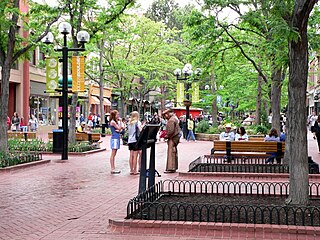
Boulder is a home rule city and the county seat of Boulder County, Colorado, United States. It is the largest city in Boulder County, with a population of 108,250 at the 2020 United States census, making it the 12th-most populous city in Colorado. Boulder is the principal city of the Boulder, CO Metropolitan Statistical Area and part of the Front Range Urban Corridor.

Tea ceremony is a ritualized practice of making and serving tea in East Asia practiced in the Sinosphere. The original term from China, literally translated as either "way of tea", "etiquette for tea or tea rite", or "art of tea" among the languages in the Sinosphere, is a cultural activity involving the ceremonial preparation and presentation of tea. Korean, Vietnamese and Japanese tea culture were inspired by the Chinese tea culture during ancient and medieval times, particularly after the successful transplant of the tea plant from Tang China to Korea, Vietnam and Japan by traveling Buddhist monks and scholars in 8th century and onwards.

Emomali Rahmon is a Tajik politician who has been serving as 3rd President of Tajikistan since 16 November 1994. Previously he was the Chairman of the Supreme Assembly of Tajikistan, as the de facto head of state from 20 November 1992 to 16 November 1994. Since 18 March 1998, he has also served as the leader of the People's Democratic Party of Tajikistan, which dominates the Parliament of Tajikistan. On 30 September 1999, he was elected vice-president of the UN General Assembly for a one-year term.
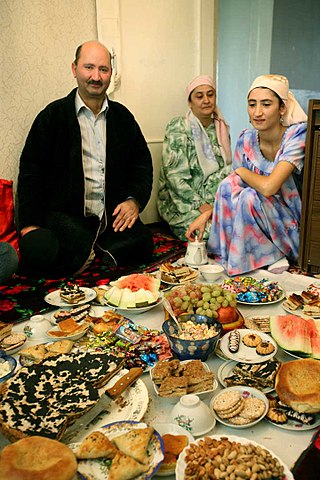
The culture of Tajikistan has developed over several thousand years. Tajik culture can be divided into two areas, Metropolitan and Kuhiston (Highland). Modern city centres include Dushanbe, Khudjand, Kulob, and Panjikent.

Bukharan Jews, in modern times also called Bukharian Jews, are an ethnoreligious Jewish sub-group of Central Asia that historically spoke Bukharian, a Judeo-Tajik dialect of the Tajik language, in turn a variety of the Persian language. Their name comes from the former Central Asian Emirate of Bukhara, which once had a sizable Jewish population. Bukharan Jews comprise Persian-speaking Jewry along with the Jews of Iran, Afghanistan, and the Caucasus Mountains. Bukharan Jews are Mizrahi Jews, like Persian, Afghan and Mountain Jews.
Jews and Judaism in Tajikistan have a long and varied history. Many of the Tajik Jews were originally Bukharan Jews.

Sunni Islam is, by far, the most widely practiced religion in Tajikistan. Sunni Islam of the Hanafi school is the recognized religious tradition of Tajikistan since 2009. According to a 2009 U.S. State Department release, the population of Tajikistan is 98% Muslim,, with some Sufi orders.
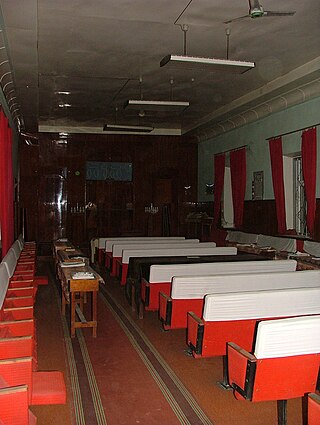
The Dushanbe Synagogue, also known as the Bukharian Synagogue, located in Dushanbe, the capital of Tajikistan, was constructed in the 19th century in one of the two Jewish Quarters in Dushanbe at the time. It was part of the Jewish community compound, which also included ritual buildings and a school. In February 2006, the Government of Tajikistan began demolition of the Jewish community compound as part of an urban redevelopment plan designed to make way for a new presidential residence, the Palace of the Nation, with adjoining landscaped areas. The demolition of the synagogue was delayed due to international protests and a series of court actions until the end of June 2008, when the old building was finally razed.
Freedom of religion in Tajikistan is provided for in Tajikistan's constitution. The country is secular by law. However, respect for religious freedom has eroded during recent years, creating some areas of concern.
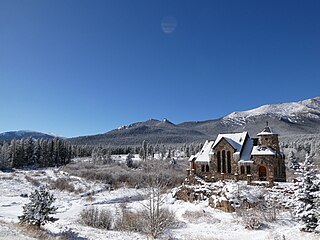
The Chapel on the Rock is a functioning Catholic chapel and tourist landmark in Allenspark, Colorado, USA. The chapel is located on the grounds of the Saint Malo Retreat, Conference, and Spiritual Center of the Catholic Archdiocese of Denver. The chapel is open to the public.

The Japanese Friendship Garden, also known as Sankei-en is a twelve-acre Japanese garden located within Balboa Park in San Diego, California. It is an expression of friendship between San Diego and its Japanese sister city Yokohama that binds the two cultures to create a unique experience for visitors from all over the world; over 240,000 people from across the United States and the world visit the garden annually. Representing a new concept in the development of a Japanese garden outside Japan, the Japanese Friendship Garden is designed to present an atmosphere of elegant simplicity (shibui) and quiet beauty. The garden's naturalistic design is guided by the original principles/techniques of the Japanese garden while incorporating elements of the regional San Diego landscape and climate; in terms of features, the garden is well known for its unique placement, sukiya-style buildings, koi ponds, and landscape exhibits. The Japanese Friendship Garden also hosts many local educational programs, activities, festivals, and horticultural classes that focus on the relationship between nature and Japanese culture.
The following is a timeline of the history of the city of Boulder, Colorado, USA.
The following is a timeline of the history of the city of Dushanbe, Tajikistan.

The Ismaili Centre, Dushanbe, is one of six Ismaili Centres worldwide and an Ismaili jamatkhana. It was the fifth purpose-built Ismaili Centre, and the first in Central Asia.
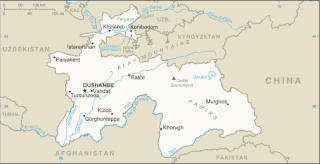
The Tajikistan–Uzbekistan border is an international border between Tajikistan and Uzbekistan. It is 1,312 kilometres (815 mi) in length and runs from the tripoint with Kyrgyzstan to the tripoint with Afghanistan.